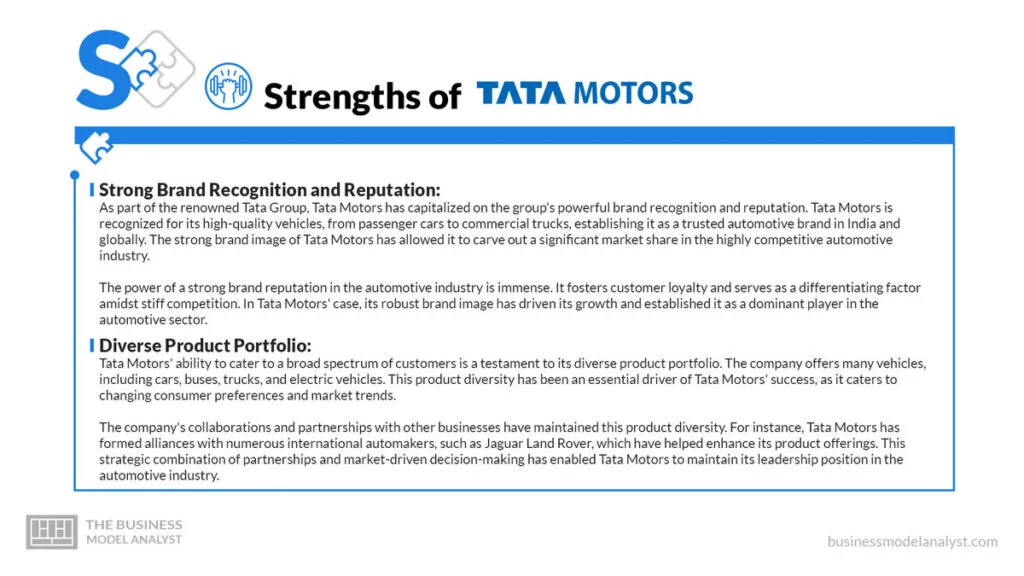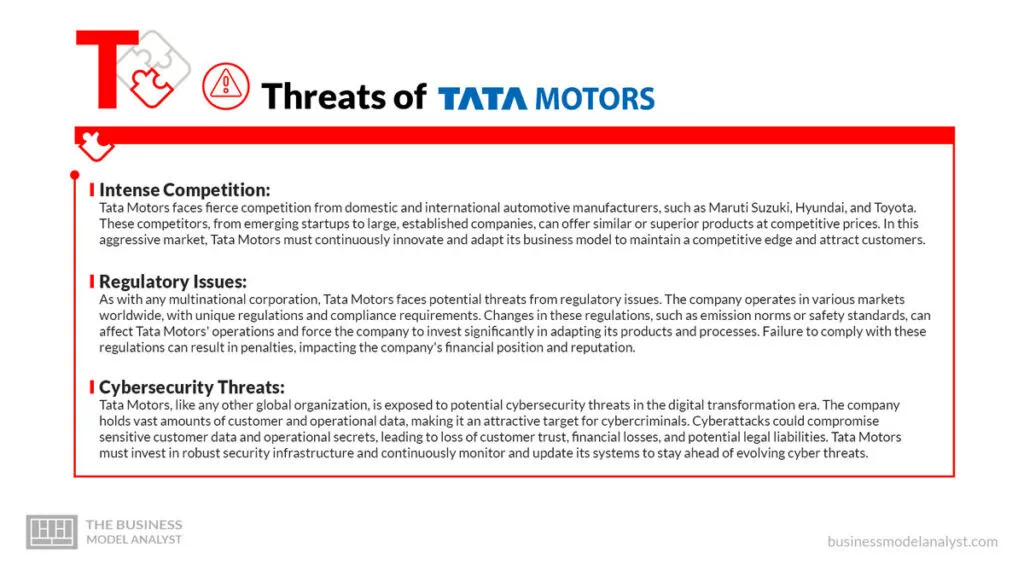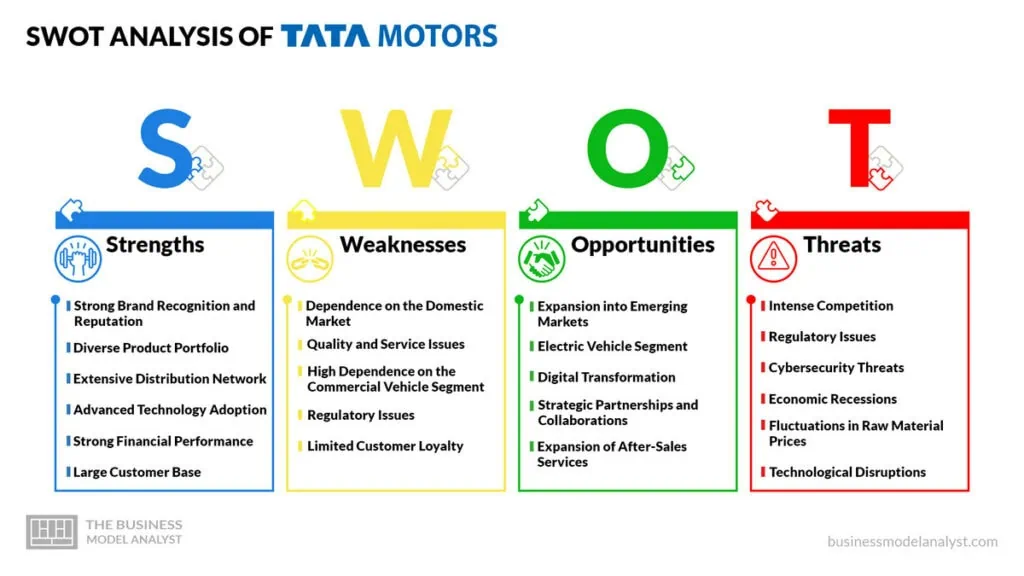The Tata Motors SWOT Analysis provides insight into the internal and external factors impacting one of India’s largest and most influential automotive companies. Founded in 1945 as part of the illustrious Tata Group, Tata Motors has etched an indelible mark in the global automotive industry. With a diverse product portfolio encompassing cars, trucks, and electric vehicles, the company has established a strong presence in numerous markets worldwide.
Whether you’re an entrepreneur keen on gleaning insights from Tata Motors‘ journey, an investor weighing options, or a business analyst studying automotive industry trends, Tata Motors’ SWOT analysis is valuable. It sheds light on the company’s inherent strengths and weaknesses, while highlighting potential opportunities and threats it may encounter. This analysis, thus, serves as a guiding compass for understanding Tata Motors‘ current market standing and projecting its future trajectory.
Contents
Tata Motors Strengths

- Strong Brand Recognition and Reputation
As part of the renowned Tata Group, Tata Motors has capitalized on the group’s powerful brand recognition and reputation. Tata Motors is recognized for its high-quality vehicles, from passenger cars to commercial trucks, establishing it as a trusted automotive brand in India and globally. The strong brand image of Tata Motors has allowed it to carve out a significant market share in the highly competitive automotive industry.
The power of a strong brand reputation in the automotive industry is immense. It fosters customer loyalty and serves as a differentiating factor amidst stiff competition. In Tata Motors’ case, its robust brand image has driven its growth and established it as a dominant player in the automotive sector.
- Diverse Product Portfolio
Tata Motors’ ability to cater to a broad spectrum of customers is a testament to its diverse product portfolio. The company offers many vehicles, including cars, buses, trucks, and electric vehicles. This product diversity has been an essential driver of Tata Motors’ success, as it caters to changing consumer preferences and market trends.
The company’s collaborations and partnerships with other businesses have maintained this product diversity. For instance, Tata Motors has formed alliances with numerous international automakers, such as Jaguar Land Rover, which have helped enhance its product offerings. This strategic combination of partnerships and market-driven decision-making has enabled Tata Motors to maintain its leadership position in the automotive industry.
- Extensive Distribution Network
Tata Motors boasts an expansive distribution network, giving it a competitive edge. Its vast network of dealerships, service centers, and parts distributors spans India and extends to several international markets. This extensive network allows Tata Motors to efficiently deliver its products and services to customers, irrespective of location.
The company has heavily invested in technology to optimize its distribution network. For instance, it uses advanced software systems to manage inventory and streamline its supply chain operations. This technological integration has helped Tata Motors maintain an efficient distribution network, significantly contributing to the company’s success.
- Advanced Technology Adoption
Tata Motors has been a trailblazer in adopting cutting-edge technologies in the automotive industry. The company has been at the forefront of the electric vehicle revolution in India, launching a range of electric vehicles that cater to different customer segments.
Tata Motors has also leveraged technology in other areas, such as its manufacturing processes and customer service. Its production facilities use advanced robotics and automation to improve efficiency and maintain quality standards. The company has also deployed digital technologies to enhance the customer buying experience, such as virtual showrooms and augmented reality. These technological advancements have helped Tata Motors stay ahead and have been instrumental in its success.
- Strong Financial Performance
Tata Motors’ robust financial performance is a testament to its operational efficiency and strategic decision-making. Despite the cyclical nature of the automotive industry, the company has consistently posted positive financial results, highlighting its ability to manage costs and drive sales.
Tata Motors has a balanced financial portfolio with a healthy mix of debt and equity. This financial stability gives the company the flexibility to make strategic investments, such as in new product development or in expanding its international presence, contributing to its sustained success.
- Large Customer Base
The variety and quality of Tata Motors’ product offerings have helped it amass a large customer base. Tata Motors’ customer-centric approach and strong brand recognition and reputation have been instrumental in attracting and retaining customers.
Furthermore, the company’s efficient distribution network has played a pivotal role in serving its large customer base. The convenience and reliability of Tata Motors’ sales and after-sales services have ensured customer satisfaction, contributing significantly to its success.
- Wide Range of Services
Tata Motors has broadened its services beyond the automotive sphere, which has helped diversify its revenue streams and reduce its reliance on vehicle sales. For instance, the company offers vehicle financing through Tata Motors Finance, significantly contributing to its revenues.
Tata Motors also provides comprehensive services, including vehicle maintenance, insurance, and extended warranties, ensuring a holistic customer experience. These services have strengthened customer loyalty and significantly impacted Tata Motors’ success.
- Strong Partnerships and Collaborations
Tata Motors has forged strategic partnerships and collaborations, strengthening its strength. The company’s acquisition of luxury carmaker Jaguar Land Rover has significantly boosted its product offerings and global presence.
The company has also collaborated with various stakeholders, such as suppliers, dealers, and technology companies, to improve its operations and offerings. These collaborations have allowed Tata Motors to stay ahead in the competitive landscape and have played a crucial role in its success.
- Global Presence with Operations in Numerous Countries
Tata Motors has successfully expanded its operations beyond Indian borders. The company’s vehicles are sold in several countries across Europe, Africa, the Middle East, Southeast Asia, and South America, demonstrating its strong global presence.
Tata Motors’ international operations have diversified its revenue streams and reduced its dependency on the Indian market. The global presence has allowed Tata Motors to tap into new growth opportunities, significantly supporting the company’s success.
Tata Motors Weaknesses

- Dependence on the Domestic Market
While Tata Motors has made strides in expanding its operations globally, it still heavily relies on the Indian market for a significant part of its revenues. Such dependence can be risky, particularly in the context of economic instability in India, which could lead to decreased consumer spending on automobiles.
In addition, the Indian automotive industry is highly competitive, with several well-established players. As such, any changes in market dynamics, consumer preferences, or the regulatory environment could significantly affect Tata Motors’ performance.
- Quality and Service Issues
Tata Motors has faced criticism and customer dissatisfaction due to issues related to the quality of its vehicles and after-sales services. Though the company has been working to improve its quality control and customer service, instances of vehicle recalls and customer complaints can harm the brand’s reputation and customer loyalty.
Ensuring superior quality and customer service is crucial in the competitive automotive industry. Failure to do so may result in lost sales, decreased market share, and damage to the brand’s image.
- High Dependence on the Commercial Vehicle Segment
Tata Motors’ business heavily leans on the commercial vehicle segment, which, although profitable, exposes the company to the cyclical nature of this sector. Economic downturns, changes in freight demand, and regulatory changes can significantly affect this segment, impacting Tata Motors’ overall performance.
While the company has been diversifying its product portfolio to include more passenger vehicles, its reliance on the commercial vehicle segment remains a significant weakness.
- Regulatory Issues
Like any other automotive manufacturer, Tata Motors faces numerous regulatory challenges. These include emission norms, safety standards, and regulations for using certain materials in vehicle manufacturing.
Changes in these regulatory frameworks can lead to increased costs for compliance and modifications in the production process, affecting the company’s profitability. Moreover, non-compliance can lead to legal consequences and harm the company’s reputation.
- Limited Customer Loyalty
Although Tata Motors has a large customer base, brand loyalty is not as strong as some of its competitors. This limitation can be attributed to past quality issues and customer service complaints. Limited customer loyalty can result in customers switching to competitors, impacting Tata Motors’ sales and market share.
Increasing customer loyalty by improving product quality and after-sales services is vital for Tata Motors to retain and attract new customers.
- Slow Pace of International Expansion
Tata Motors’ pace of international expansion has been relatively slow compared to its competitors. This slow pace has limited the company’s ability to tap into the growth potential of emerging markets and diversify its revenue streams.
Accelerating international expansion can be crucial for Tata Motors to reduce its dependence on the domestic market and tap into new growth opportunities.
- High Debt Levels
Tata Motors has relatively high levels of debt, which can be a significant weakness. High debt levels can increase interest costs, affecting the company’s profitability. It can also limit the company’s ability to invest in new projects or technologies.
It is essential to manage its debt levels efficiently for Tata Motors to ensure its financial stability and invest in future growth opportunities.
Tata Motors Opportunities

- Expansion into Emerging Markets
Expanding into new, unexplored markets, both domestically and internationally, presents a massive opportunity for Tata Motors to grow its customer base and revenue. The company could focus on markets where it has little or no presence, such as certain countries in Latin America, Africa, or Southeast Asia.
Tapping into these new markets can help Tata Motors diversify its revenue streams and decrease its dependence on the Indian market. It also allows the company to capture a larger share of the global automotive market and enhance its competitiveness. To expand successfully, Tata Motors must carefully assess the potential risks and rewards associated with each market and formulate strategies to cater to customers’ unique needs in these regions.
- Electric Vehicle Segment
The global trend of shifting towards more environmentally friendly vehicles presents a significant opportunity for Tata Motors. Investing in the research and development of electric vehicles (EVs) and hybrids can help the company position itself as a leader in this rapidly growing market segment.
Tata Motors can leverage its manufacturing capabilities and technical expertise to develop innovative and cost-effective EVs. This shift towards greener vehicles would cater to changing consumer preferences and help the company comply with stringent emission regulations worldwide.
- Digital Transformation
Embracing digital transformation in their operations and customer service could be a major opportunity for Tata Motors. Using technologies such as artificial intelligence, machine learning, and big data analytics, Tata Motors could significantly enhance its manufacturing efficiency, supply chain management, and customer experience.
Investment in digital technologies can also help the company with predictive maintenance, real-time tracking, and creating personalized customer experiences, leading to increased customer satisfaction and loyalty.
- Strategic Partnerships and Collaborations
Forming strategic partnerships and collaborations can help Tata Motors expand its technical capabilities, reach new markets, and develop innovative products. This could involve partnerships with technology companies for advanced automotive technologies, local companies for better market penetration, or alliances with other automotive companies for shared manufacturing.
These partnerships and collaborations can help Tata Motors leverage external expertise, share risks, and accelerate innovation, which can be crucial in the competitive automotive industry.
- Expansion of After-Sales Services
Expanding its after-sales services can be a significant opportunity for Tata Motors to enhance customer satisfaction and loyalty. This could involve expanding its service network, offering more comprehensive service packages, and leveraging digital technologies for service booking and maintenance reminders.
An improved after-sales service experience can help Tata Motors differentiate itself from competitors and increase customer retention. It also presents an opportunity to generate additional revenue from service packages and spare parts.
- Autonomous Vehicle Technologies
Investing in autonomous vehicle technologies presents a significant opportunity for Tata Motors to position itself as a leader in this emerging field. The development of autonomous vehicles involves technologies such as artificial intelligence, machine learning, sensor technology, and advanced driver-assistance systems (ADAS).
By investing in these technologies, Tata Motors can stay ahead of the competition and meet the future demand for autonomous vehicles. This could also open up new revenue streams for the company through technology licensing and partnerships.
- Focus on Sustainable Practices
With increasing global awareness about environmental sustainability, focusing on sustainable practices in all operations can be a key opportunity for Tata Motors. This could involve using renewable energy in their manufacturing processes, reducing waste, and promoting recycling.
Adopting sustainable practices can help Tata Motors improve its brand image, attract environmentally conscious customers, and comply with global environmental regulations. It can also lead to cost savings in the long run through the efficient use of resources.
Tata Motors Threats

- Intense Competition
Tata Motors faces fierce competition from domestic and international automotive manufacturers, such as Maruti Suzuki, Hyundai, and Toyota. These competitors, from emerging startups to large, established companies, can offer similar or superior products at competitive prices. In this aggressive market, Tata Motors must continuously innovate and adapt its business model to maintain a competitive edge and attract customers.
- Regulatory Issues
As with any multinational corporation, Tata Motors faces potential threats from regulatory issues. The company operates in various markets worldwide, with unique regulations and compliance requirements. Changes in these regulations, such as emission norms or safety standards, can affect Tata Motors’ operations and force the company to invest significantly in adapting its products and processes. Failure to comply with these regulations can result in penalties, impacting the company’s financial position and reputation.
- Cybersecurity Threats
Tata Motors, like any other global organization, is exposed to potential cybersecurity threats in the digital transformation era. The company holds vast amounts of customer and operational data, making it an attractive target for cybercriminals. Cyberattacks could compromise sensitive customer data and operational secrets, leading to loss of customer trust, financial losses, and potential legal liabilities. Tata Motors must invest in robust security infrastructure and continuously monitor and update its systems to stay ahead of evolving cyber threats.
- Economic Recessions
Economic downturns pose a significant threat to Tata Motors, as they can dramatically affect consumer spending, leading to decreased sales and profitability. During periods of economic uncertainty, customers tend to hold off on large purchases such as vehicles, impacting the company’s sales. Additionally, economic recessions can increase competition as companies strive to maintain their market share, potentially causing further declines in Tata Motors’ profitability.
- Fluctuations in Raw Material Prices
The automotive industry heavily depends on raw materials such as steel, aluminum, rubber, and plastics. Fluctuations in the prices of these materials can significantly affect Tata Motors’ manufacturing costs and, subsequently, its profitability. While some cost increases can be passed on to the consumer, competitive pressures and market conditions often limit the company’s ability to do so, impacting its margins.
- Technological Disruptions
The automotive industry is experiencing significant technological disruptions, including the shift towards electric vehicles, autonomous driving, and connected car technology. Failure to keep up with these technological advancements could leave Tata Motors behind its competitors, impacting its market position and future growth potential.
- Natural Disasters
Natural disasters such as floods, earthquakes, or pandemics can seriously threaten Tata Motors’ operations. These disasters can disrupt the company’s manufacturing processes, supply chain, and distribution network, leading to production delays and customer dissatisfaction. To mitigate this risk, Tata Motors must have contingency plans to manage the impact of natural disasters and ensure business continuity.
- Geopolitical Uncertainties
As a global company, Tata Motors is exposed to geopolitical risks, such as changes in trade policies, political instability, or conflicts in the countries where it operates. These geopolitical uncertainties can disrupt the company’s supply chain, increase operating costs, and affect its ability to do business in specific markets, impacting its profitability and growth potential.
Conclusion
Tata Motors, as a significant player in the global automotive industry, possesses several strengths that have solidified its position in the market. This includes a diverse product portfolio, a strong domestic presence, and a growing focus on innovation and technology, such as electric and autonomous vehicles.
However, the company also grapples with several weaknesses, such as inconsistent quality across its product range, financial instability, and a lack of robust global brand recognition. Tata Motors must address these weaknesses to enhance its competitive standing and profitability.
In terms of opportunities, the shift towards electric vehicles, expansion into emerging markets, and potential for increased domestic market share offer significant growth potential for the company. Tata Motors should seize these opportunities by investing in research and development, strategically entering new markets, and enhancing its domestic operations.
Conversely, the company faces substantial threats affecting its operations and profitability. Intense competition, regulatory challenges, cybersecurity threats, economic recessions, raw material price fluctuations, technological disruptions, natural disasters, and geopolitical uncertainties pose potential risks.
The SWOT analysis of Tata Motors paints a comprehensive picture of the company’s strategic position in the automotive industry. It underscores the need for continued strategic planning and execution to maximize its strengths, address its weaknesses, seize opportunities, and mitigate the threats it faces in this dynamic industry.


